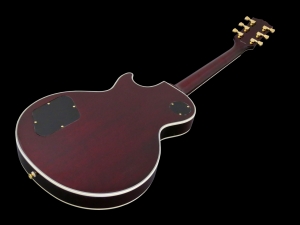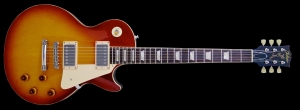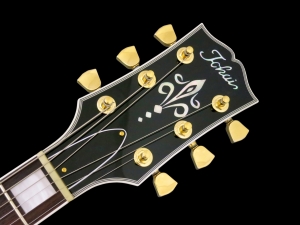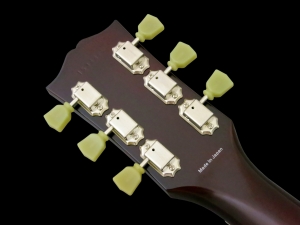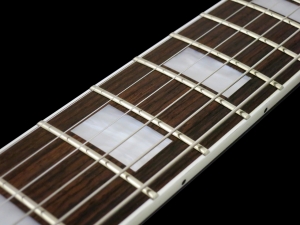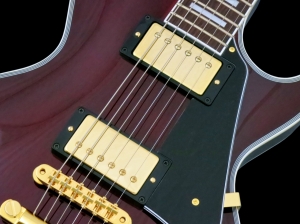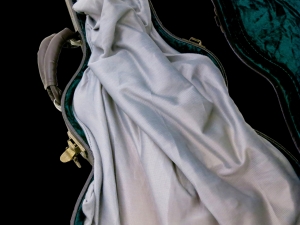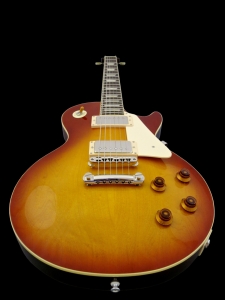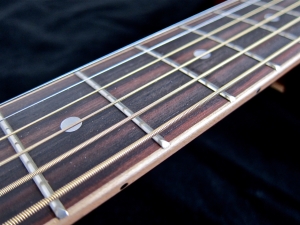Kitarablogi’s year starts off with some really tasty guitars – three Japanese Tokai Love Rock models. Handcrafted Love Rocks just like these originally laid the foundation for Tokai’s legendary reputation as a maker of high-quality copies of vintage guitars.
****
Tokai’s LC-107 (current price in Finland: 1.219 €) is the company’s gorgeous version of a Les Paul Custom.
The gold-coloured hardware fits our review sample’s tasty see-through wine red finish to a tee.
In terms of built, the Tokai LC-107 follows closely the original 1950s recipe of an LP Custom – unlike many recent original Gibsons:
The mahogany body is genuinely solid, meaning there are no hidden holes or pockets serving as weight relief. Tokai keeps the weight of their Love Rocks down by carefully selecting lightweight mahogany.
The LC-107’s curved top, too, has been carved from mahogany (!), just like Gibson did it in the Fifties.
There is one change, though, that Tokai made for environmental reasons:
The bound fingerboard is made from rosewood, not ebony.
The multiply binding on both top and back add a nice dose of panache to the looks of the Tokai LC-107.
The Tokai LS-130F (1.514) is an LP Standard-type instrument with a thin satin finish.
The letter F in its name hints at the beautiful solid flame maple top of the LS-130F.
Our review instrument comes in a beautiful tobacco sunburst, whose edges may look brown at first glance, but actually turn out to be a dark, see-through violet, allowing you to see the chatoyant wood grain beneath it.
The LS-130F’s neck and the back of the body have been finished in cherry red.
Due to the runaway popularity of tiger striped maple on Les Pauls, many younger guitarists might think that all Standards made between 1958 and ’60 have flame maple tops. Actually, there are many original ’Bursts that were produced with what is nowadays called a plain top.
Tokai’s LS-160 (1.773 €) is a stunning, top-of-the-line version of such a plain top LP.
Adding to the LS-160’s vintage-style prestige is this instrument’s nitrocellulose finish, taking this model’s specifications right back to 1958.
The headstock on the Tokai LC-107 sports plenty of inlay works, as well as multiple binding.
The tuners are modern sealed Gotoh heads.
The headstocks on both the LS-130F and the LS-160 follows the more restrained LP Standard pattern.
These two models come equipped with Gotoh’s quality versions of vintage Kluson tuners.
The Tokai LC’s sports oblong position markers made from pearloid plastic…
…while both LS’ come with crown inlays.
The fretwork on all three instruments is exemplary.
All three guitars have long tenon neck joints, with a part of the neck extending into the neck pickup cavity.
Many players claim that this type of neck joint makes for better tone and sustain.
The tune-o-matic bridges and stopbars on all three models come from Gotoh’s Japanese hardware range.
The LC-107 comes with a pair of Tokai’s fabled PAF Vintage Mark II humbuckers.
The LS-130F and LS-160 have been equipped with a pair of Seymour Duncan ’59 Model pickups.
The control cavities look clean and neat, displaying Japanese craftsmanship and parts, as well as thorough shielding with conductive paint.
Our review trio is sold with a nice Tokai hard case included in the price.
In order to protect the LS-160’s delicate nitro finish, this model is placed inside the case in its own velours bag.
****
In terms of their playability, all three guitars – the LC-107, the LS-130F and the LS-160 – are all on an equally high level. In terms of their feel, though, close inspection reveals a few minute differences.
The neck profile on the Tokai LC-107 is a medium-depth, well-rounded D-shape. LP fans would probably describe this neck as a ’59 Neck – meaning there’s enough meat on the bones for tone, but the overall dimensions are not unwieldy.
Tokai’s LS-130F comes endowed with a 58 Neck, meaning the full chunky Monty. The fantastic matte finish makes this neck feel very ”fast”, despite its considerable girth.
The LS-160’s neck profile is the slimmest neck of this trio. It’s what you call a 60 Neck – not as deep as a 59 Neck, and with an oval C-profile.
Despite the fact that all review instruments came strung with the same set of 010-strings, and notwithstanding identical setups (string height at the 12th fret: low E: 1.9 mm/treble e: 1.6 mm), Tokai’s LS-160 felt a little bit bendier than the LC-107 and LS-130F.
****
Played acoustically, the Tokai LC-107 had a sweet voice with nice woody mids and a little helping of shimmering highs, which is most likely down to the all-mahogany body.
Tokai’s own PAF Vintage Mark II pickups are great remakes of Gibson’s fabled late-Fifties humbuckers. Their output levels are relatively low, keeping the tone dynamic and fresh:
Tokai’s LS-130F turned out to be a little shouter, when strummed unplugged. This guitar gives you that famous freight-train-jumped-off-the-tracks-at-full speed experience that so many LP players love.
Seymour Duncan’s ’59 Model humbuckers make the LS-130F sound a little bit bigger and broader, when compared directly to the LC-107:
Unplugged the Tokai LS-160 sits right between its cousins. It isn’t as vociferous as the LS-130F, but there’s a bit more presence than what you’d find in the LC-107.
What is surprising, though, is that the LS-160 has the most ”vintage-accurate” tone of this trio, when plugged into an amplifier, even though the pickups are exactly the same as in the LS-130F. The neck pickup is dipped deep in tasty cream, while the bridge pickup is more dynamic and a bit brighter than many would expect from an LP Standard. The end result is a very versatile clean tone:
The demo track keeps the same guitars on clean rhythm duty throughout (left channel: LC-107; right channel: LS-160). The riffs and lead parts, on the other hand, change – first up is the LC-107, then the LS-130F, and the last to go is the LS-160:
****
Tokai’s LC-107, LS-130F and LS-160 offer you top quality for a very fair price. All three models are professional grade instruments that play like a dream and sound fantastic.
The LC-107’s woody tone makes it a good choice for Jazz- and Fusion-guitarists, but will work equally well in other genres, too.
Tokai’s LS-130F would be my choice for an all-rocking, all-riffing Love Rock. Put on your top hat and travel to Paradise City.
The LS-160 takes you all the way back to the vintage Les Pauls that have served as Tokai’s inspiration. This authentically minded vintage-style guitar is full of dynamic Bluesbreaker-mojo.
****
Tokai Love Rock
LC-107 – 1.219 € (case included)
LS-130F – 1.514 € (case included)
LS-160 – 1.773 € (case included)
Pros:
+ Made in Japan
+ workmanship
+ playability
+ sound
+ hard case included



